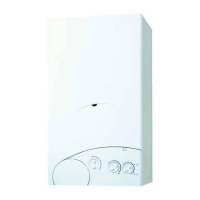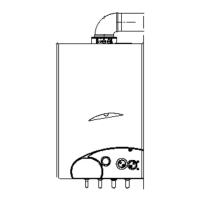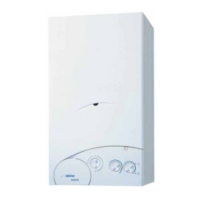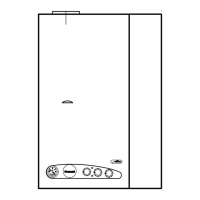NOTE: All pipework must have a continu-
ous fall from the boiler and must be resis-
tant to corrosion by condensate, copper
or steel is NOT suitable.
It should be noted that the connection of a
condensate pipe to a drain may be subject
to local building control requirements.
2.3.2 Dealing with
condensate
To drain the system, turn off the boiler, iso-
late the flow and return, and use the boiler
drain vent.
2.3.3 Requirements for sealed water
systems FORMAT DGT HE
(fig. 5/a)
The heating system design should be based
on the following information:
a)
The available pump head is given in fig. 14.
b) The burner starts when the C.H. flow
reaches 400÷450 l/h. This safety con-
dition is ensured by the flow switch.
c)
The appliance is equipped with an internal
by-pass that operates with system heads
(H) greater than 3 m. The maximum flow
through the by-pass is about 300 l/h. If
thermostatic radiator valves are to be
installed, at least one radiator should be
without a thermostatic valve (usually the
bathroom radiator or the radiator in the
room containing the room thermostat).
d) A sealed system must only be filled by a
competent person using one of the
approved methods shown in fig. 5/a.
The system design should incorporate
the connections appropriate to one of
these methods.
e) It is most important that the boiler is
not allowed to ignite until it and the
heating system is filled.
Ensure that the electrical supply to the
boiler is turned off.
Open the auto air vent, D fig 15.
Fill the system to approximately 1.5 bar.
Use the manual air vent located on the
uppermost connection to the primary
heat exchanger (item 15 fig. 3) to
release any air retained, and ensure
that all the radiators are vented.
Top up the system pressure to 1.5 bar.
Turn on the power supply to the boiler
and put the boiler in the Summer mode.
While in the Summer mode, adjust the
heating flow temperature to its mini-
mum 20 degrees. Put the boiler into
the Winter mode and allow it to ignite.
Run the boiler in this mode for approxi-
mately 30 minutes, regularly checking
that trapped any air is released. and
gradually increasing the flow tempera-
ture to 60 degrees. When inhibitor is
added repeat this procedure with the
initial flow temperature at 20 degrees.
The flow temperature should then be
set to the desired value.
2.3.4 Requirements for sealed water
systems FORMAT DGT HE SYSTEM
The heating system design should be based
on the following information:
a)
The available pump head is given in fig. 14.
b)
The appliance is equipped with an internal
by-pass that operates with system heads
(H) greater than 3 m. The maximum flow
through the by-pass is about 300 l/h. If
thermostatic radiator valves are to be
installed, at least one radiator should be
without a thermostatic valve (usually the
bathroom radiator or the radiator in the
room containing the room thermostat).
2.4 CHARACTERISTICS
OF FEEDWATER
– All recirculatory systems will be subject
to corrosion unless an appropriate
water treatment is applied.
11
ALTERNATIVE METHODS OF FILLING A SEALED SYSTEM
Fig. 5/a
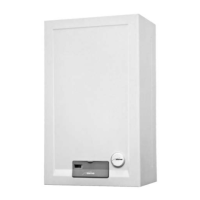
